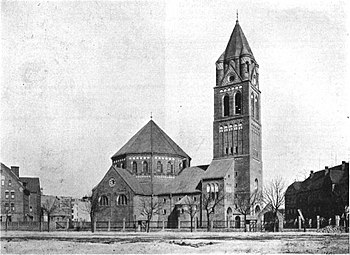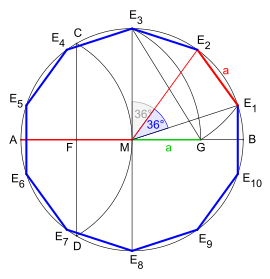decagon
In the geometry of which is decagon or decagon any polygon having ten sides and ten corners .
The regular decagon is also dealt with. It has sides of equal length and its corners lie on a common perimeter.
The only possible star (green) with the Schläfli symbol {10/3, 10/7} inscribed on this decagon is called a decagram .
Formulas
| Mathematical formulas for the regular decagon | ||
|---|---|---|
| Area |

|
|
| Length of the diagonal | ||
| Inscribed radius | ||
| Perimeter radius | ||
| Central angle | ||
| Interior angle | ||
Calculation of the area
The area of a regular decagon with the side length is calculated as follows:
Construction of a decagon
A regular decagon can be constructed with a compass and ruler .
Construction for a given perimeter
- Construct a regular pentagon (central angle = 72 °), according to the construction with compass and ruler with a given circumference .
- Draw a line from each corner of the pentagon through the center point of the circle made in step 1 to the other side of the same circle.
- The five corners of the pentagon define every other corner of the decagon. The remaining five corners are the points that were constructed by step 2 on the other side of the circle .
A possible alternative to the procedure described above is the following:
- Make the construction steps to a pentagon only so far, until the side length of the route E 3 G is determined. The vertices E 3 and E 8 result in the vertical axis of the axis cross .
- Transfer the pentagon side E 3 G determined in this way to the circumference , the first corner point E 1 of the decagon being created results.
- Halve the angle E 1 ME 3 (central angle of a pentagon), the result is the second corner point E 2 and thus the first side E 1 E 2 of the decagon.
- Determine the remaining corner points by subtracting the distance E 1 E 2 on the circumference in an anti-clockwise direction.
- Connect the neighboring corner points to each other, so the decagon is completed.
Construction for a given side length

- Denote the endpoints of side length a with E 1 and E 10
- Draw an arc around E 1 with radius E 1 E 10 through E 10 .
- Construct a perpendicular to side length a from E 1 until it intersects the circular arc around E 1 in A.
- Draw an arc around E 10 with the radius E 1 E 10 through E 1 , the points of intersection B and C.
- Draw a straight line from C through B ( center perpendicular ), it cuts the side length a in D.
- Extend the side length a from E 1 .
- Draw an arc around D with the radius AD until it intersects the extension of the side length a in F.
- Draw an arc around E 10 with the radius E 10 F , it intersects the center perpendicular of E 1 E 10 in the center M of the circumference of the decagon you are looking for.
- Draw the circumference of the resulting decagon around M with the radius R = ME 10 .
- Determine the remaining corner points by subtracting the side length a on the circumference in an anti-clockwise direction.
- Connect the neighboring corner points to each other, so the decagon is completed.
The central angle with the angular width results from the interior angles of the right triangle with the sides and (see next section The golden ratio in the decagon ) according to the Pythagorean theorem :
it follows
The golden ratio in the decagon
Both in the construction with a given circumference as well as in the given side length, the golden ratio is the decisive component by means of external division .
- In the construction, given a given circumference, the arc extends with the radius | FE 3 | around the point F the radius AM around the distance MG . The segment AG thus generated divides the center point M in the golden section .
- In the construction with a given side length, the circular arc around point D with radius | DA | an extension of the given side length E 1 E 10 by the distance E 1 F , so that the distance E 10 F is the longer distance of the ratio (see also derivation of the numerical value ).
Polyhedron with regular decagons
Some polyhedra have regular decagons as faces , for example the truncated dodecahedron and the large rhombic cuboctahedron . The polyhedra mentioned are Archimedean solids .
Occurrence
architecture


|

|
|
|
Maria, Hilfe der Christisten (Spandau) (Source: WP)
|
Mary, Help of Christians (Source: WP)
|
See also
- Temple of Minerva Medica
- Mausoleum of Theodoric
- Mausoleum of the Hohenlohe-Langenburg family
- Mausoleum of the Cirksena family
- St. Norbert (Düsseldorf)
- Emden water tower
- Water tower south (hall)
Individual evidence
- ^ A b Henry Green: Euclid's Plane Geometry, Books III – VI, Practically Applied, or Gradations in Euclid, Part II. In: books.google.de. London: Simpkin, Marshall, & CO., 1861, p. 116 , accessed February 11, 2016 .
- ↑ a b Jürgen Köller: Regular decagon, → 3rd paragraph, formulas "Is the side a given ..." In: Mathematische Handicrafts. 2005, accessed February 4, 2016 .
Web links
- Definition and properties of a decagon (English) With interactive animation


























